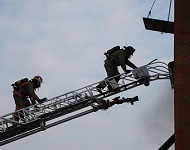

Photo by Tony Greco.
By David DeStefano
Scenario: Engine 3 rolled up to the curb at 0145 hours, just past the front of the small, three-story, 12-unit apartment building. While reporting the particulars of the building construction and occupancy, the lieutenant also noted that smoke was issuing from a top-floor window and under the soffit on side B. Considering the volume and intensity of the smoke, he transmitted the call for a working fire. As the firefighters began to remove a 1¾-inch preconnect from the hosebed, several dazed occupants began to stumble from the building. The first-in truck company—Ladder 1—was just now arriving on side A behind Engine 3. The driver/operator of the ladder company began to raise the aerial to the roof as an interior team made its way to the front entrance.
With no forcible entry required at the public entrance, Ladder 1 members ascended the stairs to the top floor. In the common corridor on the third floor, the firefighters encountered a moderate smoke condition with little heat. An apartment door at the end of the hall was held partially open by a doormat stuck between the bottom of the door and the threshold. A heavier concentration of smoke was seen rolling out the top of the door frame. With the Engine 3 hose team stretching up the stairs, the interior team from Ladder 1 began to position themselves to begin the primary search.
The Ladder 1 officer and firefighter surmised that the partially open door was likely the location of the fire apartment; they began to make their way to that position. As they reached the doorway, the heat and smoke began to intensify, leaving little doubt that they had found the fire. A radio transmission to the officer of Engine 3 now entering the fire floor rapidly brought the support of a hoseline to the proper location.
By identifying and beginning their search as close to the fire as possible, Ladder 1 had allowed Engine 3 to make an efficient stretch that helped protect the ladder company as they search the rooms close to the fire that may have contained viable victims. The protection of the hoseline would also allow for venting and to support rescue operations. In addition, if there were no victims in the immediate area of the fire, Ladder 1 would continue their primary search in the direction of an egress point. In this way, the members will be nearest the way out when there air supply is at its lowest point.
While waiting for Engine 3 to finish their stretch and start water, Ladder 1 members closed the door to the public hall, reducing the supply of fresh air and helping to contain the fire in the original apartment. In a coordinated effort, Engine 3 moved into the apartment toward the seat of the fire in the living room while the search team turned in the opposite direction to search the bedroom.
In this incident, the primary search of the fire apartment was negative, and the engine company knocked the fire down with the initial attack line. This successful knockdown with coordinated company tactics was due in large part to the efficient use of the primary search to find savable lives and the location of the fire. Following basic firefighting guidelines, Ladder 1 located and confined the fire while Engine 3 advanced their hoseline to perform extinguishment. Implementing the primary search to help achieve these objectives underscores its prime importance.
David DeStefano is a 26-year veteran of the North Providence (RI) Fire Department where he serves as captain of Ladder Co. 1. He previously served as a lieutenant in Ladder 1 and Engine 3, and was a firefighter in Ladder 1. He is an Instructor/ Coordinator for the Rhode Island Fire Academy and teaches a variety of fire service topics throughout Southern New England. He can be reached at dmd2334@cox.net.
is a 26-year veteran of the North Providence (RI) Fire Department where he serves as captain of Ladder Co. 1. He previously served as a lieutenant in Ladder 1 and Engine 3, and was a firefighter in Ladder 1. He is an Instructor/ Coordinator for the Rhode Island Fire Academy and teaches a variety of fire service topics throughout Southern New England. He can be reached at dmd2334@cox.net.
MORE ON THE LINE

